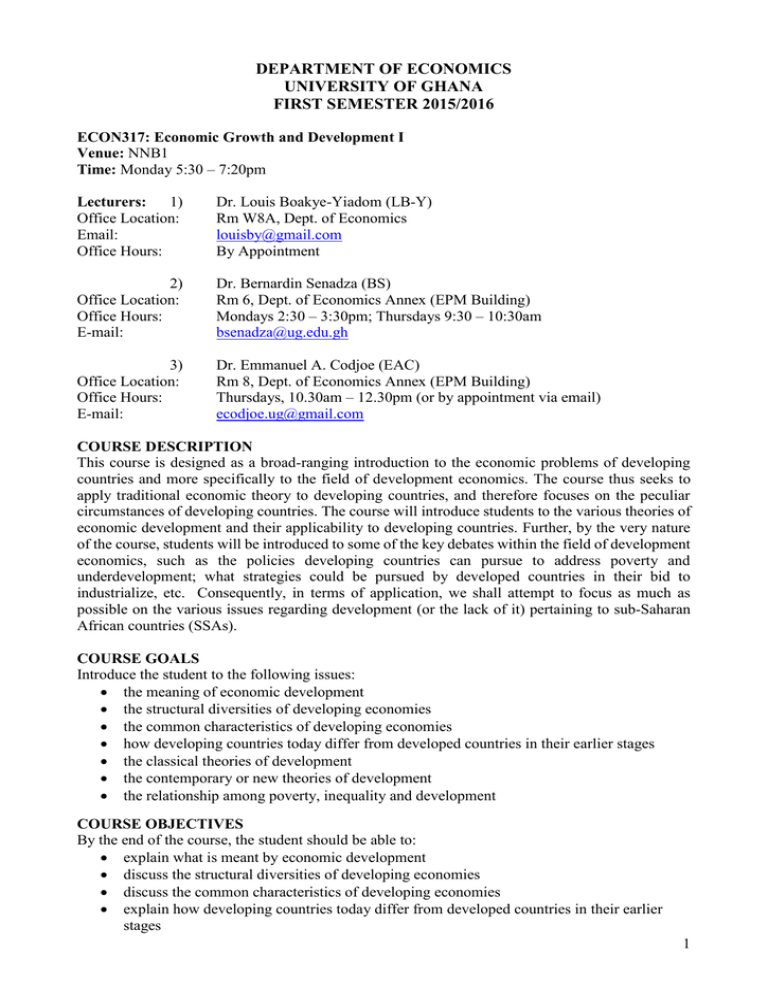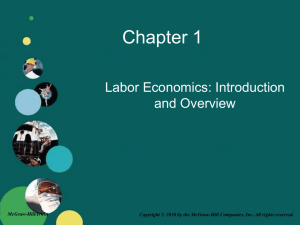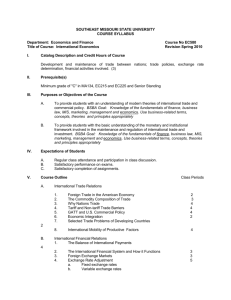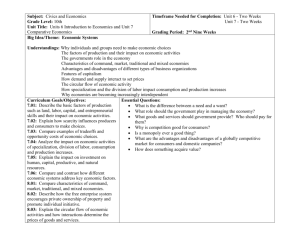
DEPARTMENT OF ECONOMICS
UNIVERSITY OF GHANA
FIRST SEMESTER 2015/2016
ECON317: Economic Growth and Development I
Venue: NNB1
Time: Monday 5:30 – 7:20pm
Lecturers:
1)
Office Location:
Email:
Office Hours:
Dr. Louis Boakye-Yiadom (LB-Y)
Rm W8A, Dept. of Economics
louisby@gmail.com
By Appointment
2)
Office Location:
Office Hours:
E-mail:
Dr. Bernardin Senadza (BS)
Rm 6, Dept. of Economics Annex (EPM Building)
Mondays 2:30 – 3:30pm; Thursdays 9:30 – 10:30am
bsenadza@ug.edu.gh
3)
Office Location:
Office Hours:
E-mail:
Dr. Emmanuel A. Codjoe (EAC)
Rm 8, Dept. of Economics Annex (EPM Building)
Thursdays, 10.30am – 12.30pm (or by appointment via email)
ecodjoe.ug@gmail.com
COURSE DESCRIPTION
This course is designed as a broad-ranging introduction to the economic problems of developing
countries and more specifically to the field of development economics. The course thus seeks to
apply traditional economic theory to developing countries, and therefore focuses on the peculiar
circumstances of developing countries. The course will introduce students to the various theories of
economic development and their applicability to developing countries. Further, by the very nature
of the course, students will be introduced to some of the key debates within the field of development
economics, such as the policies developing countries can pursue to address poverty and
underdevelopment; what strategies could be pursued by developed countries in their bid to
industrialize, etc. Consequently, in terms of application, we shall attempt to focus as much as
possible on the various issues regarding development (or the lack of it) pertaining to sub-Saharan
African countries (SSAs).
COURSE GOALS
Introduce the student to the following issues:
the meaning of economic development
the structural diversities of developing economies
the common characteristics of developing economies
how developing countries today differ from developed countries in their earlier stages
the classical theories of development
the contemporary or new theories of development
the relationship among poverty, inequality and development
COURSE OBJECTIVES
By the end of the course, the student should be able to:
explain what is meant by economic development
discuss the structural diversities of developing economies
discuss the common characteristics of developing economies
explain how developing countries today differ from developed countries in their earlier
stages
1
explain and discuss the classical theories of development
explain and discuss the new growth theories
explain the relationship among poverty, inequality and development
CLASS FORMAT
The class will consist of a series of lectures and tutorial sessions. Lectures will be interactive and
will require the involvement of students in the discussions. Attendance at lectures is compulsory.
GRADING POLICY
The course will be graded over a 100%; Interim Assessment (30%) and End of Semester Exams
(70%). Interim Assessment will be held in the 7th or 8th week (To be confirmed). Students who
do not turn up for the interim assessment will receive a score of zero.
The grading scale is as follows:
80% plus = A; 75-79 = B+; 70-74 = B; 65-69 = C+; 60-64 = C; 55-59 = D+; 50-54 = D;
45-49 = E; 44% and below = F
IMPORTANT NOTICE
Students who arrive at lectures 15 minutes or more late will be refused entry to the lecture
All mobile phones must be switched off during lectures
COURSE READINGS
There are several books on development economics or with titles related to development or the
economics of developing countries. Whilst many of these books are good, we intend to use one basic
text to allow for consistency in lecture delivery and ensure students can follow accordingly.
However several good texts are provided in the reading list, which would serve to complement our
discussions during this semester.
Main Text
1. Todaro, Michael P. and Smith, Stephen C. (2012) Economic Development, 11th Edition.
Addison-Wesley, Massachusetts
Additional Relevant Texts
2. Perkins, D.H., Radelet, S., Snodgrass, D.R., Gillis, M. and Roemer, M. (2001) Economics
of Development, 5th Edition, W.W. Norton & Company, New York
3. Meier, Gerald M., Rauch J. E. (2005) Leading Issues in Economic Development – 8th
Edition. Oxford University Press, New York
4. Weil, David N. (2005) Economic Growth, 1st Edition, Pearson- Addison Wesley
5. Killick, Tony (2010). Development Economics in Action: A Study of Economic Policies in
Ghana. 2nd ed. London and New York: Routledge.
6. Thirwall, A. P. (2003). Growth and Development: With special Reference to Developing
Countries. London: Palgrave Macmillan.
7. UNDP (various issues). Human Development Report. New York: United Nations.
(Selected chapters will be made available).
8. World Bank (1984). Towards Sustained Development in sub-Saharan Africa. Washington
D.C.: The World Bank.
9. World Bank (various issues). World Development Report. Washington D.C.: The World
Bank. (Selected chapters will be made available).
Additional reference texts and materials may be recommended during the course of the semester.
2
ADVICE: Since there is no one answer to the development problem, students are advised to be
familiar with as many Third World development experiences as possible. It is also important that
students engage in additional readings beyond what is presented in lecture notes and class
discussions. Finally, regular attendance to class is strongly encouraged.
LECTURE OUTLINE AND READINGS
Weeks 1, 2:
Economics, Institutions, and Development: A Global Perspective [EAC]
How the other half live
Economics and Development Studies
Economies as social systems: The need to go beyond simple economics
What do we mean by development
Key Reading: Todaro & Smith, Chapter 1
Weeks 3, 4:
Comparative Development: Differences and Commonalities among Developing
Countries [EAC]
Defining the developing world
The structural diversity of developing economies
Common characteristics of developing nations
How developing countries today differ from developed countries in their earlier
stages
Are living standards of developing and developed countries converging?
Key Reading: Todaro & Smith, Chapter 2
Weeks 5-7:
Classic Theories of Economic Development [LB-Y]
Development as growth and the Linear-Stage Theories
Structural-Change models
The International-Dependence Revolution
The Neoclassical Counterrevolution
Key Reading: Todaro & Smith, Chapter 3
Weeks 8, 9:
Contemporary Models of Development and Underdevelopment [LB-Y]
The new growth theory: Endogenous growth
Underdevelopment as a coordination failure
The Big Push
Problems of Multiple Equilibria
Kremer’s O-Ring Theory of Economic Development
Key Reading: Todaro & Smith, Chapter 4
Weeks 10-13: Poverty, Inequality and Development [BS]
Measuring inequality and poverty
Poverty, inequality, and social welfare
Absolute poverty: Extent and magnitude
Economic characteristics of poverty groups
Policy options for reducing poverty and inequality in developing countries
Key Reading: Todaro & Smith, Chapter 5
3







